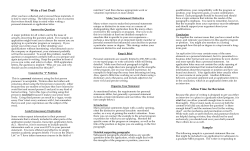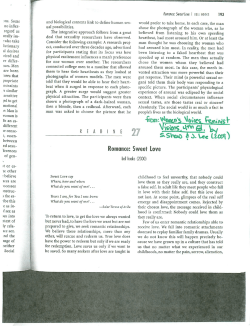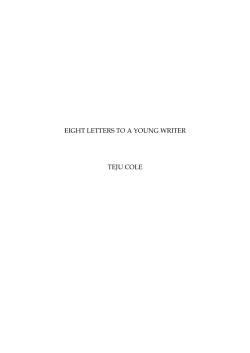
Writing for the Romance Book Market
Writing for the Romance Book Market First the good news: the romance market is one of the most accessible to new writers. Some publishers read everything submitted to them and authors are generally not required to be represented by an agent. The bad news: it’s a fiercely competitive market with a huge and discerning international readership that doesn’t tolerate a tongue-in-cheek approach. It helps if you read and appreciate romance novels. They are primarily an escapist entertainment medium, but this does not mean they can be trite or badly written. Nor does it mean formulaic. The structure which requires a hero, a heroine, a struggle (conflict) and a happy ending, is not more formulaic than that of a crime novel which requires a dead body, a detective, assorted suspects and red herrings, and a surprise solution. The structure identifies the book as belonging to a genre (family) of books. Change the essential structure, say by having an unhappy ending, and you may have a great novel but it probably won’t appeal to a romance publisher. It’s a good idea to read as many current romance novels as you can, and obtain writers’ guidelines (also called tip sheets) from publishers. Work within the required structure and you can write your book your way. Romance publishers say they are actively seeking fresh, original ideas within the romance genre. Can My Heroine Be a Nude Mud-Wrestler? Fresh and original doesn’t mean way out or bizarre. Traditional storylines such as twins mistaken for each other, a ‘marriage of convenience’ (where the characters marry for reasons other than love) and one or other character acquiring amnesia and forgetting the relationship, are still popular with readers the world over. This is where knowing the market is vital. Know what’s ‘hot’ and what stories have been done to death. Then write your own version of a long-time favourite so well that it reads like a brand new idea. What Makes a Great Hero or Heroine? Indulge your fantasies. Both should be strong, independent, successful people in their own right. Beware of making the modern hero too domineering and macho. These days he is more the heroine’s equal, although he still should fulfil her every fantasy in a man. Likewise, she should meet all of his. But don’t let her sit at home waiting for Mr Right. She may want a man to complement her well-rounded life, but she doesn’t need him in order to exist. And don’t get so involved creating conflict between the characters that we can’t understand how they could ever fall in love. Let us see the process happening gradually as they get to know each other. Let us share their ambivalence. They could fall in love if not for (whatever problem you’ve created between them). The Last Romance I Read Had No Conflict At All! Are you sure? Many new writers mistake arguing and bickering for conflict. Think of conflict as a source of tension, a struggle over values, or something both characters want but only one can have. It must be sustainable for 50,000+ words. Even if your characters disagree ever so politely, we should have no doubt that it’s a struggle to the death. Conflict should not be confused with a ‘situation’. Veteran romance novelists, Daphne Claire and Robyn Donald quote a heroine expecting a female housekeeper and getting a male one, as an example of an opening situation. It gets the couple together. The real source of tension will come from why she has a problem with a man doing her housework and why he would take the job. Find the answers in their respective pasts and put them on a collision course and you have a real source of conflict. Environmental issues are not popular with romance publishers because someone has to be the ‘bad guy’. But if you have made your heroine a developer and your hero an environmentalist, look for solid reasons in their past why they hold these viewpoints. Why is the heroine hell-bent on tearing up the green sward? Give her reasons that show her character in a good light, such as a wish to provide housing for underprivileged children because she was homeless herself once, then contrast this with his reasons for his attachment to the land. It’s even better if you can find a more original source of conflict emerging from who your people are. Out Of Your Emotional Depth Romance readers are as interested in how the characters feel about their experiences as in what actually happens to them. Good advice is to put in as much emotional content as you think you need – then double it. Whenever something happens to the hero or heroine, ask yourself how they feel about it. Then don’t tell us about it – ‘she was angry’ – show us by sharing what she actually does to demonstrate anger – throws the hero’s clothes out the window, pours paint over his classic car, what? And let us get inside her head to see exactly what emotions his actions have triggered in her – and why, based on her past history. Contrast with her awareness of how attractive she finds him. Let us share their struggle to resolve the problem between them while fighting the attraction they feel. These days it’s desirable to show the hero’s point of view as well as the heroine’s. This needs judicious handling to avoid diffusing the tension. One way is to show the hero’s viewpoint only when he has a problem with the heroine, then he can focus on what she’s done to aggravate him. If we see too much of how attractive he finds the heroine, we may wonder why he doesn’t just sweep her off her feet and be done with it. Emotions are there to evoke emotions in the reader. As one editor says ‘the power of a story is in ... the ability of the author to engage a reader’s emotions and to convincingly portray a full spectrum of the human experience’. Love scenes are preferable to so-called ‘sex scenes’. Sex is the ultimate expression of human caring so don’t short-change your readers. Be spicy, steamy, ‘fog up the glasses’ as one editor requested, but keep language and tone romantic. Only write what you’re comfortable with and submit to a publisher who agrees with your preference. A ‘sweet’ (unsexy) romance will not suit a line known for its sensuality. Where Do I Start? Preferably not with the heroine gazing out of a plane or train window, ruminating about where she’s going. Instead, choose a turning point in her life, when she’s about to experience a major change – a new job, a new boss, a loss (property or a child, for instance). If she doesn’t like the change, so much the better. She’s going to be dragged into the change kicking and screaming. The Romans called it in medias res – in the middle of things. 2 ASA: Writing for the Romance Book Market Having hooked your reader by plunging her into the action right away, keep the story moving. Middlepage spread hits many new writers who find themselves fighting to keep the characters from falling into each other’s arms. The solution is cause and effect. Something happens, therefore, something else must happen which leads to the next event, each arising naturally out of what has gone before. Editors describe the pacing of a romance novel as ‘like the ebb and flow of the tide’ allowing for moments of high conflict and moments of rapport as the characters get to know each other sufficiently to fall in love. Happily Ever After Reader expectation demands a happy or at least satisfying ending that ties up all the loose ends, clears up any misunderstandings and follows through any foreshadowed plot points. It should leave the reader on an emotional high and eager to read your next story. Settings Modern romances are largely dialogue-driven with little narrative and character introspection, so share background details judiciously, more as flavouring than main ingredient. Publishers generally spell out their requirements in their tip sheets. Australian settings and most places other than known trouble spots are acceptable as background, but some US publishers require either the hero or heroine to be American. Be guided by the tip sheet and don’t submit material that contravenes basic requirements. Can Men Write Romance Novels? They can and do, either under their own name or a female pseudonym. The late Tom Huff wrote as Jennifer Wilde, while Mike Hinkemyer writes as Vanessa Royale. In category fiction (short romances such as those published by Harlequin Mills & Boon and Silhouette) some well-loved female pen-names conceal male writers, while some books are written by couples, giving the books a balance of male and female points of view. Men need to train themselves to think and feel from a woman’s point of view. Editors say male writers tend to use harsher words than women writers and to glorify physical features that women tend not to regard as beautiful. If in doubt, read books such as Beatrice Faust’s Women, Sex and Pornography or books on the psychological differences between men and women such as John Gray’s Men Are From Mars, Women Are From Venus. Approaching a Publisher Most publishers including Harlequin Mills & Boon ask you to query them first with your idea. In a onepage carefully crafted letter you should: • Summarise your writing background, membership of writers’ organisations and relevant published work or prizes Summarise the plot of your book, key characters, conflict and resolution • • Demonstrate familiarity with the genre by mentioning the line your book should suit, eg. Harlequin Intrigue, Silhouette Special Editions etc. Consult the publisher’s guidelines for specifics and read as many examples of that line as you can. If you’re asked to submit a proposal (also called a partial) include the query letter, short synopsis (2 to 10 pages or as specified in the tip sheet) and the first three chapters in order. Don’t send any other combinations of chapters. Even if submitting a partial, it’s a good idea to finish the manuscript at least in draft. You can take account of any editorial suggestions you’re offered and still respond within a reasonable time. 3 ASA: Writing for the Romance Book Market Your Manuscript The usual rules of manuscript preparation apply: double spacing, wide margins, clear printing on one side of the paper only. Most publishers prefer a hard copy to computer disks. Don’t bind your work in any way. Cut some stiff cardboard to size as a backing sheet and secure the loose pages to it with large elastic bands at right angles. If submitting overseas, include sufficient international reply coupons from the post office to cover full return postage, or ask that the manuscript be recycled if it proves unsuitable. Sometimes it costs less to print a fresh copy. You also should keep the original copy. A contract is normally offered on acceptance of a complete manuscript, sometimes of a partial if the writer is already established. You can save yourself much angst by having the ASA or a contract-savvy lawyer vet the document before you sign it. Advances generally start from around AUS $1000 to $10,000 or more for a mainstream romance. Some publishers offer half the advance on signing and the other half on acceptance; or split it between signing, acceptance and publication or some other combination depending on policy. Romance publishers traditionally pay low royalties, between four and six per cent of cover price, but worldwide sales and translations can number in the millions. You should still plan on three to five years of steady acceptances before you even think of giving up your day job! Organisations and Resources Romance Writers of Australia Inc PO Box 1236 Neutral Bay NSW 2089 Phone: 0429 233 764 Web: www.romanceaustralia.com Holds an annual conference with overseas editors and writers, runs several awards including The Valerie Parv Award for unpublished authors, convenes romance writing groups and the Isolated Writers Scheme, and publishes a regular newsletter Heart Talk. Romance Writers of America 14615 Benfer Road Houston TX 77069 USA Phone: (+1) 832 717 5200 Fax: (+1) 832 717 5201 Email: info@rwanational.org Web: www.rwanational.org Romantic Times Magazine 55 Bergen St Brooklyn New York NY 11201 USA Phone: (+1) 718 237 1097 Fax: (+1) 718 624 4231 Email: rtinfo@romantictimes.com WEB: www.romantictimes.com © Valerie Parv Australian Society of Authors Limited, 2009 (6th Edition) Originally published in 1999 4 ASA: Writing for the Romance Book Market ROMANCE BOOK PUBLISHERS We suggest you use this list as a starting point. Publishers’ submission policies will change from time to time, therefore it is advisable to contact each publisher to establish submission guidelines (including change of address and changes in corporate ownership) or check writers’ guidelines on the website before sending unsolicited manuscripts. Direct your queries to either the Acquisitions Editor or the Executive Editor. Many of these publishers do not list their phone and fax numbers, as they prefer to be contacted by mail only. Please note that some publishers on this list will only accept manuscripts through recognised agents. Australian publishers have not been listed because editorial submissions are usually made through their overseas offices. Details were correct at the date of publication. The ASA accepts no responsibility for changes made since. AVALON BOOKS 160 Madison Ave 5th Floor New York NY 10016 USA Ph: (+1) 212 598 0222 Fax: (+1) 212 979 1862 Email: avalon@avalonbooks.com Web: www.avalonbooks.com HARLEQUIN MILLS & BOON Eton House 18-24 Paradise Rd Richmond, Surrey TW9 1SR UK Email: submissions@hmb.co.uk Web: www.eharlequin.com AVON BOOKS/HARPERCOLLINS 10 East 53rd St New York NY 10022 USA Ph: (+1) 212 207 7000 Web:www.harpercollins.com/imprints/Avon/ DORCHESTER PUBLISHING COMPANY 200 Madison Ave Suite 2000 New York NY 10016 USA Email: submissions@dorchesterpub.com Web: www.dorchesterpub.com HARLEQUIN BOOKS/MIRA BOOKS 225 Duncan Mill Rd Don Mills Ontario M3B 3K9 CANADA Ph: (+1) 888 432 4879 Web: www.eharlequin.com POCKET BOOKS 1230 Avenue of the Americas New York NY 10020 USA Ph: (+1) 212 698 7000 Web: http://romance.simonandschuster.com RED SAGE PUBLISHING Florida USA Ph: (+1) 727 391 3847 Web: www.eredsage.com ST. MARTIN’S PRESS 175 Fifth Ave New York NY 10010 USA Fax: (+1) 212 677 7456 Web: http://us.macmillan.com/smp.aspx Australian Society of Authors ABN 26 008 558 790 PO Box 1566, Strawberry Hills NSW 2012 T: 02 9318 0877 | F: 02 9318 0530 asa@asauthors.org | www.asauthors.org Copyright © 2010 Australian Society of Authors Detail from ASA Medal design by Darrell Sibosado
© Copyright 2025





















